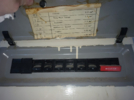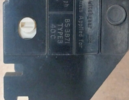There was a similar thread on another forum where we got a picture of the consumer unit

which seems to be the old Dorman Smith LoadMaster type. I have seen them listed on the internet as C curve and type 3 but the problem is they need removing to read the type

as written on the side. I know it was 1 to 4 before we went to B to D but I can't remember off hand what a type 3 curve was? and clearly we have no idea what the type is. I remember using them in the early 90's but even then they were old. As to young lads knowing the old system!
Yes the guy at the Consumer Unit had a tester with him.
But the guy at the cooker would have needed to test the loop impedance.
I would recommend a change of CU, as to if code 3 or code 2 not so sure, I know the regulations say what date they apply, but that's OK if one is given paperwork stating the design date, other wise one must consider it was designed yesterday.
Of course we have no idea if this is the CU fitted in your house, but "Two guys just came out, about 18 and 19." they seem too young, to be qualified normally one needs to be 21 years old +, it has always been the same, dad started apprenticeship at 14 of 5 years and 2 years journeyman, I started it was at 16 but only 5 years and day release, and latter school leaving age was increased and the apprenticeship was further shortened but with block release. But net result is 21 before qualified.
The Emma Shaw court case made it very clear that people not trained to do inspection and testing must not be used, even just to take the readings with a meter.
electrical-testing-safety.co.uk said:
Evidence at the inquest revealed that when the electrics were installed, a series of errors were made. These included an unqualified electrician's mate testing and approving the wiring in the flat. The inquest heard that four safety documents that the mate had filled out, and which were checked by the company's supervisor, also had a number of errors in them.
odd in the account on the IET forum it was the supervisor who was blamed not the guy doing the testing.
We sign forms J Blogs, and in the main there is nothing to say what training J Blogs has received. We only get letters behind our name at over level 3 and most electricians only train to level three, and even if signed J Blogs Fdeng one has not idea of what that was in, I know when I did mine there were three courses all sharing some subjects and all have the same letters one was motor vehicle.
And what I was taught doing my C&G 2391 was not included when I did my Fdeng, and it is the C&G 2391 which is the important one.



